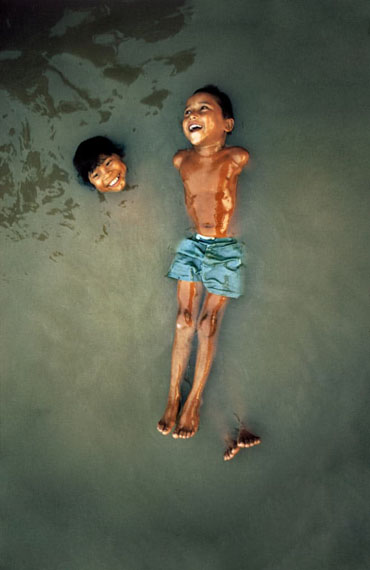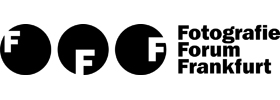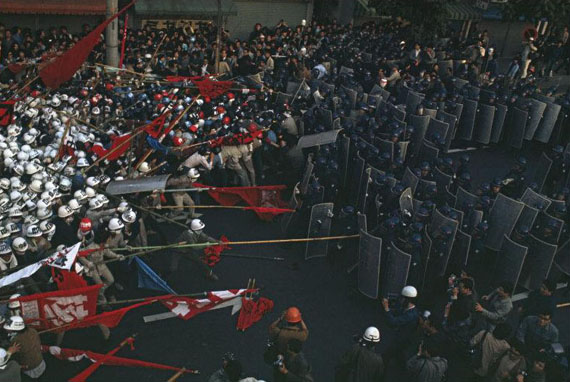
Belém, Pará, Brazil, 1966
© Bruno Barbey / Magnum Photos
Bruno Barbey »
PASSAGES
Exhibition: 9 Sep 2017 – 14 Jan 2018
Fri 8 Sep 19:00

FFF Fotografie Forum Frankfurt
Braubachstr. 30-32
60311 Frankfurt (Main)
+49 (0)69-291726
contact@fffrankfurt.org
www.fffrankfurt.org
Tue-Sun 11-18

Demonstration against the construction of the Narita Airport and the war of Vietnam, Tokyo, Japan, 1971
© Bruno Barbey / Magnum Photos
Bruno Barbey
"PASSAGES"
Exhibition: 9 September, 2017 – 14 January, 2018
Opening: Friday, 8 September, 7 pm
Moments of a carefree childhood, the respectful gaze into foreign cultures or aspects of the humane during political conflict and war: the diversity of his topics and his insightful image vocabulary have shaped the career of Bruno Barbey (*1941) as one of the most successful photojournalists of our time. With BRUNO BARBEY "PASSAGES" the Fotografie Forum Frankfurt presents the oeuvre of the French photographer. On display are 100 photographs in black-and-white and colour, from the early 1960s until today. Additionally, films by Caroline Thiénot-Barbey, the wife of the photographer are on view, giving unique insight to Barbey’s work and approach.
The exhibition presents images and photo reportages of Bruno Barbey from all over the world. The earliest examples presented include the black-and-white images from the series "Les Italiens", Barbey’s first photo essay (1961–1964). As a student Barbey travelled to Italy numerous times, absorbed by the spirited atmosphere of the cities and the people that seemed to instantly feel relaxed in front of the camera and stage their lives on the streets much like a theatre. To capture the spirit of this nation became his goal. Fascinated by neorealist film, by encounters with the author Alberto Moravia or the painter Carlo Levi and led by the audacity of youth Barbey made more than 10,000 images across Italy. The series "Les Italiens" earned him his first publication in the major magazines Du and Camera as well as his membership with Magnum Photos at the age of 25.
The French artist became a pioneer of colour photography in 1966 with a photo assignment for Vogue in Brazil. Captivated by the intense hues and contrasts of the country, he worked with colour film for the first time "even though the quality of reproduction was poor in magazines." Barbey travelled through the Amazon, photographed people and the day-to-day life along the river banks. He received worldwide recognition for his images of cheerfully bathing children in Belém or the iconic image of the boys jumping into the river near Leticia.
Later the wonderfully vibrant impressions of Morocco, the home of his childhood, reveal his virtuosity in the use of colours. Again, and again, he is drawn back to the country where he spent the first twelve years of his life. The call of the mu'addhin, the waves breaking on the shores of the ocean and the scents of spices have deeply inscribed themselves into his memory, the blue of the ceramics, the ochre of the walls, the interaction of light and shadow, have had a great impact on his perception. And yet working with the camera would have been difficult in the traditional culture of Morocco, the artist desribed in conversation with the author Carole Naggar in his book "Passages" (Edition La Martinière, 2015). Images had to be either created very quickly – or could only be made after a long period of waiting: "Morocco has really meant years of patience," says Barbey.
Years in which the photojournalist Barbey travelled across all five continents. His intuitive curiosity, openness and a fine sense of historical developments often brought him to the global trouble spots before other colleagues. Another focus of the exhibition are Barbey’s documentations of large world events — the Six-Day War in the Middle East, the Vietnam War, the 1968s student demonstrations, Poland during the era of Solidarność, or the Iraq war at the beginning of the 1990s.
Burning oil fields, pillars of smoke after air raids: despite many images depicting war, Barbey does not conceive of himself as a war photographer: "I refuse the aesthetics of madness and horror," he writes in one of his books. Instead, he was ever interested in the consequences of conflict on civilians; especially women, children and refugees. He sees and presents these as the true victims of war — as well as the child soldiers whom he photographed in many parts of Africa, Cambodia and Palestine. He has been described as a "chronicler of change and a vulnerable world".
The exhibition "PASSAGES" illustrates Bruno Barbey’s unique position in the history of recent photography, his precise methodology and poetic vision with images that keep the balance between distance, proximity and empathy for the beauty and fragility of existence. "Barbey’s compositional approach orchestrates intuitive and poetic timelessness, be it historical world events or contemporary observations — and this ongoing since the beginning of his career as a photographer", says Celina Lunsford, Artistic Director of the Fotografie Forum Frankfurt. A "rendezvous with history", as he once said. As well as rendezvous with life.
The Fotografie Forum Frankfurt presents BRUNO BARBEY »PASSAGES« in collaboration with Bruno Barbey (www.brunobarbey.com) and Maison Européene de la Photographie, Paris. The exhibition is part of the Guest of Honour Programme "Frankfurt in Frenc"” of this year’s Frankfurt Book Fair.
�

Bosphoros Bridge, Istanbul, Turkey, 2009
© Bruno Barbey / Magnum Photos
Bruno Barbey
"PASSAGES"
Ausstellung: 9. September 2017 bis 14. Januar 2018
Eröffnung: Freitag, 8. September 2017, 19 Uhr
Ob Momente unbeschwerter Kindheit, der respektvolle Blick in fremde Kulturen oder Aspekte des Menschlichen in politischen Konflikten und Kriegen: Die Vielfalt seiner Themen und seine einfühlsame Bildsprache machen Bruno Barbey (*1941) zu einem der erfolgreichsten Fotojournalisten der Gegenwart. Mit BRUNO BARBEY »PASSAGES« zeigt das Fotografie Forum Frankfurt eine Retrospektive des französischen Fotografen. Zu sehen sind 100 Schwarzweiß- und Farbfotografien der frühen 1960er Jahre bis heute. Zusätzliche Einblicke in Barbeys besondere Arbeitsweise vermitteln Filme von Caroline Thiénot-Barbey, Filmemacherin und Ehefrau des Fotografen.
Die Ausstellung präsentiert Bilder und Fotoreportagen von Bruno Barbey aus aller Welt. Den zeitlichen Anfang markieren Schwarzweißbilder aus "Les Italiens", Barbeys erstem Fotoessay (1961–1964). Als Student reiste Barbey immer wieder nach Italien, beeindruckt von der lebendigen Atmosphäre in den Städten, von den Menschen, die sich vor seiner Kamera gleich wohl zu fühlen schienen und ihr Leben auf den Straßen inszenierten, als sei es ein Theater. Den Geist dieser Nation mit der Kamera einzufangen, wurde sein Ziel. Fasziniert vom neorealistischen Film, von Begegnungen mit dem Schriftsteller Alberto Moravia oder dem Maler Carlo Levi und geleitet von seiner jugendlichen Unbekümmertheit machte Barbey mehr als 10.000 Aufnahmen in ganz Italien. Die Serie "Les Italiens" brachte ihm erste Veröffentlichungen in den großen Magazinen Du und Camera – und mit 25 Jahren die Mitgliedschaft bei Magnum Photos.
Zum Pionier der journalistischen Farbfotografie wurde der Franzose 1966 mit einem Fotoauftrag für Vogue in Brasilien. Begeistert von den intensiven Farben und Kontrasten des Landes arbeitete er dabei erstmals mit Farbfilm, "obwohl die Qualität der Reproduktionen in den Magazinen schlecht war". Barbey bereiste den Amazonas, fotografierte Menschen und Alltag am Wasser. Weltbekannt sind seine Aufnahmen von fröhlich badenden Kindern in Belém oder das Bild der Jungen, die bei Leticia übermütig in den Fluss springen.
Seinen meisterhaften Umgang mit Farben belegen später vor allem vielfältige Aufnahmen aus Marokko, der Heimat seiner Kindheit. Immer wieder zieht es Barbey in das Land, wo er die ersten zwölf Jahre seines Lebens verbrachte. Der Ruf des Muezzins, der Wellenschlag des Meeres, die Gerüche der Gewürze haben sich tief in seine Erinnerung gegraben, das Blau der Keramik, das Ocker der Wände, das Spiel von Licht und Schatten seine Wahrnehmung geprägt. Und doch sei die Arbeit mit der Kamera in Marokko aus kulturellen Gründen schwierig gewesen, berichtet der Künstler im Gespräch mit der Autorin Carole Naggar in seinem Buch "Passages" (Edition La Martinière, 2015). Bilder mussten entweder sehr schnell entstehen – oder mit langem Warten: "Marokko bedeutete Jahre Geduld", so Barbey.
Jahre, in denen der Fotojournalist auf allen fünf Kontinenten unterwegs war. Intuitive Neugier, Offenheit und ein feines Gespür für historische Entwicklungen führten ihn mitten in die Brennpunkte, oft vor anderen Kollegen. Seine Dokumentationen großer politischer Welt-ereignisse bilden einen Schwerpunkt der Schau im FFF: Sechstagekrieg im Nahen Osten, Vietnamkrieg, die 1968er Studentenunruhen, Polen zur Zeit von Solidarność oder der Irak-Krieg Anfang der 1990er Jahre.
Brennende Ölfelder, Rauchsäulen nach Bombenangriffen: Trotz zahlreicher Kriegsbilder versteht Barbey sich nicht als Kriegsfotograf. "Ich verweigere mich der Ästhetik von Wahnsinn und Schrecken", schrieb er in einem seiner Bücher. Stattdessen interessierten ihn die Auswirkung von Konflikten auf Zivilisten, vor allem auf Frauen, Kinder und Flüchtlinge. Sie sieht und zeigt er als die wahren Opfer des Krieges – ebenso wie die Kindersoldaten, die er in Afrika, Kambodscha und bei den Palästinensern fotografierte. Als "Chronist des Wandels und einer verletzlichen Welt", wie es einmal über ihn hieß.
Die Ausstellung "PASSAGES" illustriert Bruno Barbeys einzigartige Position in der Geschichte der jüngeren Fotografie: Präzise in der Arbeitsweise, poetisch in der Sicht. Seine Bilder berichten von großer Empathie für die Schönheit und die Zerbrechlichkeit des Seins. "Ob bei der Dokumentation des Weltgeschehens oder zeitgenössischen Beobachtungen: Bruno Barbeys künstlerischem Ansatz ist immer eine intuitive und poetische Zeitlosigkeit zueigen", sagt Celina Lunsford, künstlerische Leiterin des Fotografie Forum Frankfurt, "und das von Beginn seiner Karriere an."
Als "Rendezvous with history" hat Barbey seine Arbeit mit der Kamera selbst einmal charakterisiert. Ebenso spürbar ist immer auch sein Rendezvous mit dem Leben.
Das FFF zeigt BRUNO BARBEY "PASSAGES" in Kooperation mit Bruno Barbey (www.brunobarbey.com) und dem Maison Européenne de la Photographie, Paris. Die Ausstellung ist zugleich Beitrag des FFF zum Ehrengastprogramm "Frankfurt auf Französisch" der Frankfurter Buchmesse 2017.
RAHMENPROGRAMM:
VORTRAG "PASSAGES" mit Bruno Barbey (in englischer Sprache)
Samstag, 9. September, 19 Uhr
KURATORENFÜHRUNG mit Celina Lunsford
10. September 2017, 1. Oktober 2017, 14. Januar 2018, jeweils sonntags, 15 Uhr
WORKSHOP "WATCHING THE STREET" mit Bruno Barbey (in englischer Sprache)
Samstag/Sonntag, 9./10. September, 10–18 Uhr
WORKSHOP "DAS FOTOBUCH" mit Wolfgang Zuborn und Markus Schaden
Samstag/Sonntag, 28./29. Oktober, 10–18 Uhr �

Moulay Ismael Mausoleum, Meknes, Morocco, 1985
© Bruno Barbey / Magnum Photos

The Amazon River, Leticia, Amazonas, Brazil, 1966
© Bruno Barbey / Magnum Photos